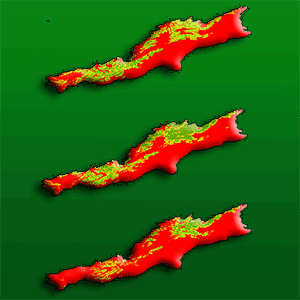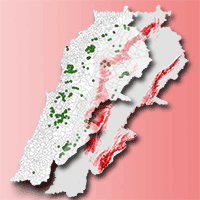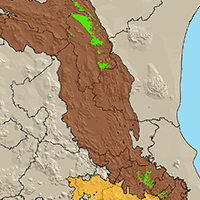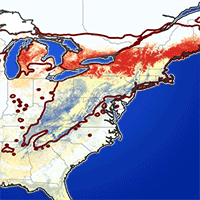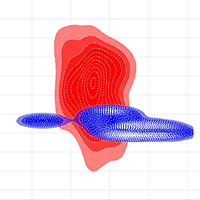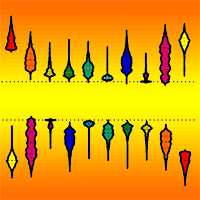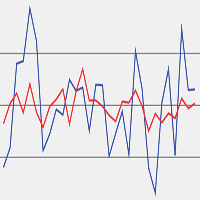In recent years, global climate change has had significant biological, temporal, and spatial effects on many terrestrial habitats. The objective of this study was to evaluate the effect of climate change on the geographic distribution of Juniperus excelsa and prioritize its habitats for protection against these effects until 2070. The study was conducted using the MaxEnt species distribution model and two data series GFDL-CM3 and MRI-CGCM3 under scenarios RCP2.6 and RCP4.5 of the 5th IPCC report. Our results revealed that elevation, minimum temperature of coldest month, precipitation of coldest quarter, annual mean temperature, and slope aspect, in that order, have the greatest effects on the species’ distribution in the study area. Under optimistic scenario RCP2.6, both models predicted that the species’ presence area will grow, but under RCP4.5, models predicted that by 2070, some parts of its habitat in western and central heights will be lost because of change in climate parameters like minimum temperature of coldest month and precipitation of coldest quarter. Under the latter scenario, the northeastern parts of the study area showed no changes in terms of climatic parameters and climatic niche. The results of both climate data series indicated that the Juniperus excelsa will slowly migrate to higher elevations to cope with the changing climate. Assessment of the results through field studies showed that outputs of GFDL-CM3 are closer to the reality.
Keywords
, , , ,
Citation
Fatemi SS, Rahimi M, Tarkesh M, Ravanbakhsh H (2018). Predicting the impacts of climate change on the distribution of Juniperus excelsa M. Bieb. in the central and eastern Alborz Mountains, Iran. iForest 11: 643-650. - doi: 10.3832/ifor2559-011
Academic Editor
Paolo Cherubini
Paper history
Received: Jul 19, 2017
Accepted: Jul 22, 2018
First online: Oct 04, 2018
Publication Date: Oct 31, 2018
Publication Time: 2.47 months
© SISEF - The Italian Society of Silviculture and Forest Ecology 2018
Open Access
This article is distributed under the terms of the Creative Commons Attribution-Non Commercial 4.0 International (https://creativecommons.org/licenses/by-nc/4.0/), which permits unrestricted use, distribution, and reproduction in any medium, provided you give appropriate credit to the original author(s) and the source, provide a link to the Creative Commons license, and indicate if changes were made.

Breakdown by View Type
(Waiting for server response...)
Article Usage
Total Article Views: 49865
(from publication date up to now)
Breakdown by View Type
HTML Page Views: 40689
Abstract Page Views: 4207
PDF Downloads: 3994
Citation/Reference Downloads: 4
XML Downloads: 971
Web Metrics
Days since publication: 2629
Overall contacts: 49865
Avg. contacts per week: 132.77
Article Citations
Article citations are based on data periodically collected from the Clarivate Web of Science web site
(last update: Mar 2025)
Total number of cites (since 2018): 23
Average cites per year: 2.88
Publication Metrics
by Dimensions ©
Articles citing this article
List of the papers citing this article based on CrossRef Cited-by.
(1)
Allouche O, Tsoar A, Kadmon R (2006)Assessing the accuracy of species distribution models: prevalence, kappa and the true skill statistic (TSS). Journal of Applied Ecology 43 (6): 1223-1232.
CrossRef |
Gscholar
(2)
Anderson RP, Lew D, Peterson AT (2003)Evaluating predictive models of species’ distributions: criteria for selecting optimal models. Ecological Modelling 162: 211-232.
CrossRef |
Gscholar
(3)
Anderson RP, Gonzalez JI (2011)Species-specific tuning increases robustness to sampling bias in models of species distributions: an implementation with Maxent. Ecological Modelling 222 (15): 2796-2811.
CrossRef |
Gscholar
(4)
Araújo MB, Alagador D, Cabeza M, Nogués-Bravo D, Thuiller W (2011)Climate change threatens European conservation areas. Ecology letters 14 (5): 484-492.
CrossRef |
Gscholar
(5)
Barbet-Massin M, Jiguet F, Albert CH, Thuiller W (2012)Selecting pseudo-absences for species distribution models: how, where and how many? Methods in Ecology and Evolution 3 (2): 327-338.
CrossRef |
Gscholar
(6)
Bellard C, Bertelsmeier C, Leadley P, Thuiller W, Courchamp F (2012)Impacts of climate change on the future of biodiversity. Ecology letters 15: 365-377.
CrossRef |
Gscholar
(7)
Brzeziecki B, Kienast F, Wildi O (1995)Modeling potential impacts of climate change on the spatial distribution of zonal forest communities in Switzerland. Journal of Vegetation Science 6: 257-258.
CrossRef |
Gscholar
(8)
Choudhury MR, Deb P, Singha H, Chakdar B, Medhi M (2016)Predicting the probable distribution and threat of invasive
Mimosa diplotricha Suavalle and
Mikania micrantha Kunth in a protected tropical grassland. Ecological Engineering 97: 23-31.
CrossRef |
Gscholar
(9)
Elith J, Leathwick JR (2009)Species distribution models: ecological explanation and prediction across space and time. Annual Review of Ecology, Evolution and Systematics 40 (1): 677-697.
CrossRef |
Gscholar
(10)
Elith J, Graham CH, Anderson RP, Dudik M, Ferrier S, Guisan A, Hijmans RJ, Huettmann F, Leathwick JR, Lehmann A, Li J, Lohmann LG, Loiselle BA, Manion G, Moritz C, Nakamura M, Nakazawa Y, McOverton JC, Peterson AT, Phillips SJ, Richardson KS, Scachetti-Pereira R, Schapire RE, Soberon J, Williams S, Wisz MS, Zimmermann NE (2006)Novel methods improve prediction of species distributions from occurrence data. Ecography 29: 129-151.
CrossRef |
Gscholar
(11)
Elith J, Phillips SJ, Hastie T, Dudik M, Chee YE, Yates CJ (2011)A statistical explanation of MaxEnt for ecologists. Diversity and Distributions 17: 43-57.
CrossRef |
Gscholar
(12)
Fallah A, Balapour Sh Yekekhani M, Jalilvand H (2014)Dendrochronological studies of
Juniperus polycarpos in Alborz Mountains (case study: Shahkuh of shahrood). Iranian Journal of Wood and Paper Science Research 29 (1): 94-105.
Online |
Gscholar
(13)
Ferrarini A, Rossi G, Mondoni A, Orsenigo S (2014)Prediction of climate warming impacts on plant species could be more complex than expected. Evidence from a case study in the Himalaya. Ecological Complexity 20: 307-314.
CrossRef |
Gscholar
(14)
Fischer HS (1990)Simulating the distribution of plant communities in an alpine landscape. Coenoses 5: 37-43.
Online |
Gscholar
(15)
Franklin J (2010)Mapping species distributions: spatial inference and prediction. Cambridge University Press, Cambridge, UK, pp. 319.
Online |
Gscholar
(16)
Frey W, Probst W (1986)A synopsis of the vegetation in Iran. In: “Contributions to the Vegetation of Southwest Asia”. Ludwig Reichert Verlag, Wiesbaden, Germany, pp. 9-43.
Gscholar
(17)
Graham CH, Elith J, Hijmans RJ, Guisan A, Townsend Peterson A, Loiselle BA, The NCEAS Predicting Species Distributions Working Group (2008)The influence of spatial errors in species occurrence data used in distribution models. Journal of Applied Ecology 45: 239-247.
CrossRef |
Gscholar
(18)
Guisan A, Theurillat JP (2000)Equilibrium modelling of alpine plant distribution and climate change: how far can we go? Phytocoenologia 30: 353-384.
CrossRef |
Gscholar
(19)
Guisan A, Zimmermann NE (2000)Predictive habitat distribution models in ecology. Ecological Modelling 135: 147-186.
CrossRef |
Gscholar
(20)
Guisan A, Edwards TC, Hastie T (2002)Generalized linear and generalized additive models in studies of species distributions: setting the scene. Ecological Modelling 157: 89-100.
CrossRef |
Gscholar
(21)
Hall JB (1984)Juniperus excelsa in Africa: a biogeographical study of an Afromontane tree. Journal of Biogeography 11 (1): 47-61.
CrossRef |
Gscholar
(22)
Havlik P, Valin H, Gusti M, Schmid E, Leclère D, Forsell N, Herrero M, Khabarov N, Mosnier A, Cantele M, Obersteiner M (2015)Climate change impacts and mitigation in the developing world. An integrated assessment of the agriculture and forestry sectors. World Bank Group, Washington, DC, USA, pp. 56.
Online |
Gscholar
(23)
Hijmans RJ, Cameron SE, Parra JL, Jones PG, Jarvis A (2005)Very high resolution interpolated climate surfaces for global land areas. International Journal of Climatology 25 (15): 1965-1978.
CrossRef |
Gscholar
(24)
Hirzel AH, Hausser J, Chessel D, Perrin N (2002)Ecological-niche factor analysis: how to compute habitat suitability maps without absence data. Ecology 83: 2027-2036.
CrossRef |
Gscholar
(25)
IUCN (2016)The IUCN red list of threatened species (ver. 2016-2). Web site.
Online |
Gscholar
(26)
Khanum R, Mumtaz AS, Kumar S (2013)Predicting impacts of climate change on medicinal asclepiads of Pakistan using Maxent modeling. Acta Oecologica 49: 23-31.
CrossRef |
Gscholar
(27)
Lehmann A, Overton JM, Leathwick JR (2002)GRASP: generalized regression analysis and spatial predictions. Ecological Modelling 157: 187-205.
CrossRef |
Gscholar
(28)
Li G, Xu G, Guo K, Du S (2016)Geographical boundary and climatic analysis of
Pinus tabulaeformis in China: insights on its afforestation. Ecological Engineering 86: 75-84.
CrossRef |
Gscholar
(29)
Miller JA, Rogan J (2007)Using GIS and remote sensing for ecological modeling and monitoring. In: “Integration of GIS and remote sensing” (Mesev V ed). John Wiley and Sons Ltd, UK, pp. 233-268.
Online |
Gscholar
(30)
Miller J (2010)Species distribution modeling. Geography Compass 4/6: 490-509.
CrossRef |
Gscholar
(31)
Mori AS, Spies TA, Sudmeier-Rieux K, Rade A (2013)Reframing ecosystem management in the era of climate change: issues and knowledge from forests. Biological Conservation 165: 115-127.
CrossRef |
Gscholar
(32)
Mátyás C (2010)Forests and climate change in Eastern Europe and Central Asia. Forests and Climate Change Working Paper no. 8, Food and Agriculture Organization of the United Nations, Rome, Italy, pp. 189.
Online |
Gscholar
(33)
Munoz J, Felicisimo AM (2004)A comparison between some statistical methods commonly used in predictive modeling. Journal of Vegetation Science 15: 285-292.
CrossRef |
Gscholar
(34)
Parra JL, Graham CC, Freile JF (2004)Evaluating alternative data sets for ecological niche models of birds in the Andes. Ecography 27: 350-360.
CrossRef |
Gscholar
(35)
Phillips SJ, Anderson RP, Schapire RE (2006)Maximum entropy modeling of species geographic distributions. Ecological Modelling 190: 231-259.
CrossRef |
Gscholar
(36)
Pourtahmasi K, Parsapajouh D, Marvi Mohajer M, Ali-Ahmad-Korouri S (2008)Evaluation of Juniper trees (
Juniperus polycarpos C. Koch) radial growth in three sites of Iran by using dendrochronology. Iranian Journal of Forest and Poplar Research 16 (2): 342-347.
Gscholar
(37)
Priti H, Aravind NA, Shaanker RU, Ravikanth G (2016)Modeling impacts of future climate on the distribution of Myristicaceae species in the Western Ghats, India. Ecological Engineering 89: 14-23.
CrossRef |
Gscholar
(38)
Ravanbakhsh H, Moshki A (2016)The influence of environmental variables on distribution patterns of Irano-Turanian forests in Alborz Mountains, Iran. Journal of Mountain Science 13 (8): 1375-1386.
CrossRef |
Gscholar
(39)
Ravanbakhsh H, MarvieMohajer MR, Asadi M, Zobeiri M, Etemad V (2013)Classification of
Juniperus excelsa M. Bieb forests vegetation and its analysis of relationship with environmental variables. Forest and Wood Product (Iranian Journal of Natural Resources) 66 (3): 277-292.
Gscholar
(40)
Ravanbakhsh H, Hamzehee B, Etemad V, Marvie Mohajer MR, Assadi M (2016)Phytosociology of
Juniperus excelsa M. Bieb. forests in Alborz mountain range in the north of Iran. Plant Biosystems 150 (5): 987-1000.
CrossRef |
Gscholar
(41)
Remya K, Ramachandran A, Jayakumar S (2015)Predicting the current and future suitable habitat distribution of
Myristica dactyloides Gaertn. using MaxEnt model in the Eastern Ghats, India. Ecological Engineering 82: 184-188.
CrossRef |
Gscholar
(42)
Sagheb-Talebi K, Sajedi T, Pourhashemi M (2014)Irano-Turanian region in forests of Iran. In: “Forests of Iran: A Treasure from the Past, a Hope for the Future”. Springer Science and Business Media, Netherlands, pp. 67-113.
Gscholar
(43)
Sarangzai AM, Ahmed M, Ahmed A, Tareen L, Jan SU (2012)The ecology and dynamics of
Juniperus excelsa forest in Balochistan-Pakistan. Pakistan Journal of Botany 44 (5): 1617-1625.
Online |
Gscholar
(44)
Sass-Klaassen U, Leuschner HH, Buerkert A, Helle G (2007)Tree-ring analysis of
Juniperus excelsa from the northern Oman Mountains. In: Proceedings of the “Dendrosymposium 2007”, Riga (Latvia) 3-6 May 2007, pp. 99-108.
Gscholar
(45)
Segurado P, Araujo MB (2004)An evaluation of methods for modelling species distributions. Journal of Biogeography 31: 1555-1568.
CrossRef |
Gscholar
(46)
Tarkesh M, Jetschke G (2012)Comparison of six correlative models in predictive vegetation mapping on a local scale. Environmental and Ecological Statistics 19 (3): 437-457.
CrossRef |
Gscholar
(47)
Warren R, Van Der Wal J, Price J, Welbergen JA, Atkinson I, Ramirez-Villegas J, Osborn TJ, Jarvis A, Shoo LP, Williams SE, Lowe J (2013)Quantifying the benefit of early climate change mitigation in avoiding biodiversity loss. Nature Climate Change 3 (7): 678-682.
CrossRef |
Gscholar
(48)
Yang XQ, Kushwaha SPS, Saran S, Xu J, Roy PS (2013)Maxent modeling for predicting the potential distribution of medicinal plant,
Justicia adhatoda L. in lesser Himalayan foothills. Ecological Engineering 51: 83-87.
CrossRef |
Gscholar
(49)
Yu J, Wang C, Wan J, Han S, Wang Q, Nie S (2014)A model-based method to evaluate the ability of nature reserves to protect endangered tree species in the context of climate change. Forest Ecology and Management 327: 48-54.
CrossRef |
Gscholar
(50)
Yukimoto S, Adachi Y, Hosaka M, Sakami T, Yoshimura H, Hirabara M, Mizuta R (2012)A new global climate model of the Meteorological Research Institute: MRI-CGCM3 model description and basic performance. Journal of the Meteorological Society of Japan 90: 23-64.
CrossRef |
Gscholar
(51)
Zohary M (1973)Geobotanical foundation of the Middle East. Taylor and Francis, UK, pp. 765.
Gscholar
